How is pilgrimage different from just a long walk? Why do we feel a calling to pilgrimage even when not religious? How does pilgrimage connect us to our physicality, and simplify life so we find some perspective? Kevin Donahue talks about some of his ‘sacred steps’ on various pilgrimage routes across Europe.
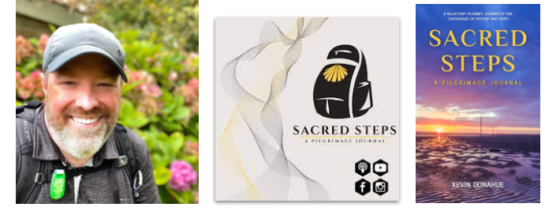
Kevin Donahue began walking pilgrimage routes in 2019 and hosts the ‘Sacred Steps Podcast,’ where he discusses pilgrimage with fellow pilgrims. He’s currently writing a book, Sacred Steps: A Pilgrim’s Journal, out in 2023.
Show notes
- How is pilgrimage different from a long walk?
- Why pilgrimage resonates even to those who are not religious
- Highlights of Kevin’s pilgrimage, including the crossing to Holy Island, Lindisfarne
- The challenges of pilgrimage — and the gifts that only emerge later
- Tips for the Camino Portuguese route — wear shoes with thicker soles for the cobblestones!
- Recommended books on pilgrimage
You can find Kevin Donahue at SacredStepsPodcast.com and on Instagram @kevincdonahue
You can listen to my interview on Kevin’s podcast about my pilgrimage to Canterbury here.
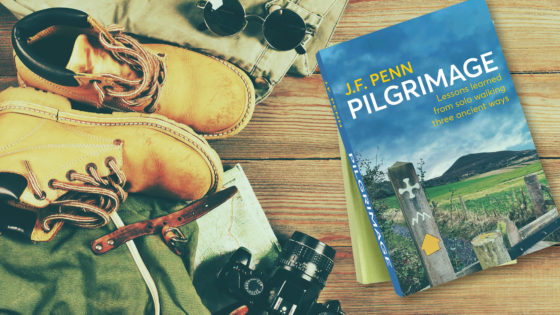
Transcript of the interview
Jo: Kevin Donahue began walking pilgrimage routes in 2019, and hosts the Sacred Steps Podcast, where he discusses pilgrimage with fellow pilgrims. He’s currently writing a book, Sacred Steps: A Pilgrim’s Journal, out in 2023. Welcome, Kevin.
Kevin: Thanks, Jo. It’s great to be on. I appreciate getting a chance to talk with you today.
Jo: I’ve been on your show discussing my pilgrimage and you talk about pilgrimage a lot. And so, this is fascinating, but let’s start with a definition.
What is pilgrimage? How is it different from a long walk?
Kevin: That’s a great question, Jo, and I think this is something that’s really a bit intimidating for people when they hear the word ‘pilgrimage.’
I didn’t really know what that meant to me as a walker at first. I went to the Webster’s children’s dictionary, because, for me, if Webster could explain it to a child, surely that could be something I would understand. And the dictionary said, look at pilgrimage and then look at pilgrim, a person who travels to a holy place as an act of religious devotion.
That made a lot of sense to me. Because when you think about devotion, that gets into intention and purpose. And if you’re walking with this intent, versus a long walk, which you and I have both actually done a lot of, Jo, but pilgrimage is as much about the journey as it is the destination.
I think it’s those moments of greater awareness, either about ourselves or, to some degree, maybe our faith or our world, or how we interact and engage with the world around us, that really makes pilgrimage so rewarding. And it’s that spirit of each step of the journey having significance, rather than just the beginning or the end. It’s the full process, I think, that makes pilgrimage much different than just a long walk.
Jo: That’s really interesting. We’ll come back to some of those aspects, but I noticed that you call yourself a ‘reluctant pilgrim’ on your website.
Where does this reluctance come from, and what happened in your life to get you over that?
Kevin: I’ve had the opportunity in the United States to do some of our national scenic trails, and we have some great ones. I’ve walked along the Appalachian Trail, haven’t finished the whole thing just yet, the Florida National Scenic Trail. I’ve walked out in the western United States. And like you said, those are long walks.
I had always wanted to do the Camino de Santiago in Spain. And I made the decision, but as it grew closer, I really didn’t understand the concept of pilgrimage and how it related to me. So, I jokingly said I was a very reluctant pilgrim, because I didn’t set out to be a pilgrim or to go on pilgrimage. I wanted to have this bucket list experience, this life-affirming socialization, walking in the footsteps of history, where people had trod for a thousand-plus years. And that seemed really like a great, great walk for me.
It’s those other elements that intervened throughout the process that really reconnected me in some ways to my faith, because I was, I think what we would call ‘lapsed but listening,’ where you can be someone who maybe follows Christ as a Christian, but not necessarily follows the orthodoxy and teachings maybe of a Christian church or denomination.
Being on that walk and going through some of the places that I got to experience, which, I think that’s the great part about pilgrimage, you come and engage with these different places and people, that really, I think you said, what was it that sparked? I think for me, that’s what maybe pushed me over the edge a little bit and changed my long walk into a pilgrimage. And I think it’s something that happens for each person very individually, and perhaps quite a bit differently.
Jo: It’s interesting because as we talked about before, I’m not a Christian, but I would say I’m a seeker and I find moments of connection with the divine, I suppose, or the universe. But I definitely do not follow a Christian religion, or any particular religion.
It’s interesting because you started off by defining a sort of traveling to a holy place as an act of religious devotion, and that pilgrimage is going to these holy places.
And I always feel like even if we don’t adhere to a particular religion, there’s something about pilgrimage that touches a part of every person’s soul, if they have any form of kind of spiritual seeking. And so, it’s not just that it has to be a Christian faith or any kind of, because the pilgrimage is obviously in every religion.
What do you think about pilgrimage transcending religion in a way?
Kevin: Oh, you are spot on, Jo. There’s a great organization in the UK, the British Pilgrimage Trust, and their mantra is that they want to enliven pilgrimage for people of all faiths and none. I think that’s such a powerful mission statement. Because it speaks to so much of what these special places have meant in our lives collectively, for centuries and millennia.
We look across the UK and there are these sacred places that we know had such great value to our ancestors. One of the obvious ones that stands out for U.S. tourists is Stonehenge. Or up the road in Avebury, Woodhenge. And you say to yourself, ‘I’m standing in a place where people have journeyed here for centuries.’
And, to your point, that’s obviously not a Christian church. There’s no cross and steeple. But clearly, people have held that space in high regard. And it might have been something where people had journeyed from a great distance to come to be in this space.
I think we can all recognize that there are these places where we feel a greater sense of purpose or a greater sense of connectivity, whether that’s with something spiritual, or whether it’s with our own self-identity and feeling of self-worth.
I think pilgrimage does mean something different to everyone, but I think it has meaning to everyone. And, again, I think that’s a bit about what separates pilgrimage from a long journey is that it’s the process of making that trip that has significance to the person that’s undertaking it.
Jo: Absolutely. And that resonance with faith in whatever over the generations, and a resonance with that emotional connection and people of faith in a particular place, I almost feel leave an imprint that, and that’s almost what we feel. You can feel that it’s God touching you, and it may be that, but you can also feel that it’s connection to people across millennia.
I remember being at Stonehenge once, and there weren’t many people there. It was winter. It was freezing cold, and there was a murmuration of swallows or swifts or the murmuration when the birds flock in shapes above Stonehenge. And I was standing there going, ‘This has to be some kind of divine experience.’ It was a crazy kind of experience, and feeling like I was connecting to this sort of deep Earth power, whatever it was.
Like you say, there are places where we feel that connection with people across time, I suppose.
Kevin: We’ve talked about that a little bit on my podcast, the ‘Sacred Steps Podcast.’ My guests are not formally Christians. I’ve had the opportunity to talk to people of no faith, and people who are Buddhist and people who are Muslim. These journeys have great weight and significance for people.
You can go into a space, and it might be a church. We’ve talked about, Jo, you love the architecture and the devotion that people have made into creating these spaces, and the beauty that resonates with them.
And you can be in a space that man has made, a church or what have you, and you can feel a significance that is not necessarily tied to a particular orthodoxy.
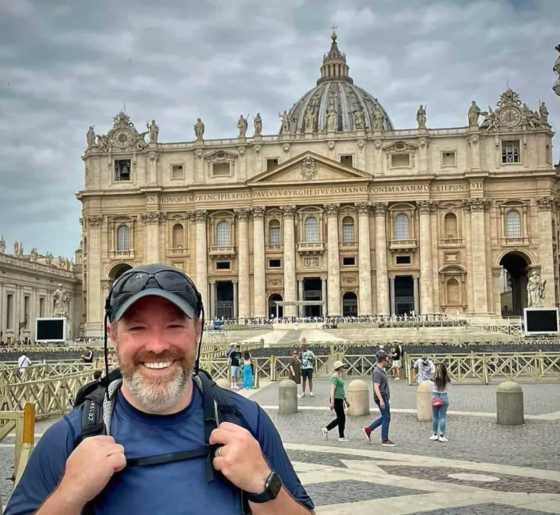
I think whether you’re going to these ancient sites, whether you’re journeying to…and there are a lot of places where our different faith practices hold in high regard. Their wells and their caves and their springs, but natural places that you find out in the landscape. Also, these sometimes grand shrines that man has made in practice of faith. Being in these spaces, to your point, you sometimes feel like that’s a very special space, and you’ve arrived at just the right moment.
Jo: Absolutely. Let’s talk about some of the various pilgrim routes that you’ve done, because you’ve done some bits of quite a lot of different ones. You and I almost met in person on the Cuthbert’s Way, but you were ahead of me going over to Lindisfarne.
Why did you decide to approach pilgrimage in a patchwork, as opposed to walking the whole length of one?
Kevin: Great question, Jo. It’s more a product of necessity than intent.
Let’s circle back to that definition of what makes pilgrimage unique. The importance of the journey itself, step by step. Surely, then, one of the elements of pilgrimage is that it is not defined by just a singular starting point or a singular endpoint, although most frequently, we’re all walking to one spot.
1,000 years ago, a pilgrim would have begun their journey at their door, and walked towards this particular holy place or this particular significant location. And now, we kind of leave our homes and we jump on the train or we get on the airplane and we journey off to this starting point. We’re a bit constrained, at least I know I am, by how much time we can devote to that journey.
So, it’s time away from family. I have a teenage son, and there’s an investment of time factor. And then also, how much time you can take away from work or what have you. As a career person in the United States, we get a certain amount of vacation time.
I’ve always been trying to balance, I think, the purpose of my journey. Why do I want to do this walk? Versus what can I commit fully to the pilgrimage? For me, sometimes it’s only been a week or a couple of weeks that I can be away. And some of these walks are intimidatingly long. You and I have talked about the Camino de Santiago, from St. James, a walk like that’s five or six weeks, and you say, ‘Well, wow, I can’t devote that.’
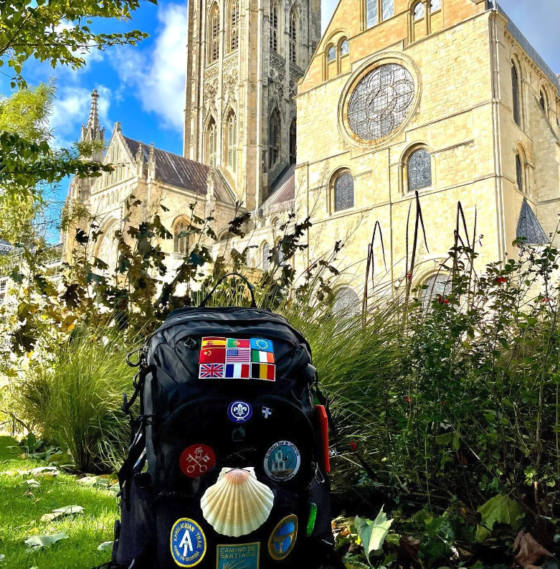
But I’ve come to learn, and a good friend of mine, English author, Andy Bull, wrote a book called Pilgrim Pathways where he looks at weekend walks, getting into these special spaces, where you’re only devoting a small amount of time because that’s what you have available.
For me, and I want to talk to you a little bit about where I’ve been, but in some instances, it’s been more of a product of what time can I devote to this pilgrimage has defined in some ways the length that I’ve been able to walk. I’ve had to start in some places that had significance for me, that maybe weren’t at the ‘starting gate.’ So, that’s been an interesting part of it.
Jo: I think this is so important, because humanity just makes up rules for things. And it’s like, there’s a measurement of everything that we do. Clearly, the pilgrimage where someone walks for six months from Canterbury to Jerusalem is far more holy than you (!), who only walked for a week or…
Kevin: I would think it would be.
Jo: As you said, it’s about the intention, it’s about the purpose. If it’s an act of religious devotion, and you walk to your local church on a Sunday.
They say on the Camino, don’t they? ‘Walk your own Camino.’
There shouldn’t be judgment or self-judgment around what we did. It’s funny, isn’t it? We always just impose these rules on things.
Kevin: My self-judgment was on full display the day after I arrived in Santiago de Compostela on the Camino de Santiago. You make these walks, and I had done not a long distance. I had done about 100 miles.
I walked the Camino Portuguese section, up through Spain. I was feeling quite proud of myself. I had done this long walk and I had walked along further than some. I was pretty proud of that.
There was some ego there. And there was this lady in the cathedral, and she must have been, I don’t know, 80 years old, 80-plus years old, and she had her walking stick. She was going from the pew straight up to the front of the church. And it was, from my perspective, it looked to be everything she could do to make that walk.
And here I was feeling so proud of myself, in my younger condition, that I had walked 100 miles or whatever. And here she was making a walk that was every bit as meaningful to her, and probably every bit as challenging as mine had been to me. I had to check my ego a little bit, because how we define a pilgrim and how we define that distance of pilgrimage, to your point, we put a lot of rules and a lot of vanity around it. It’s more about what someone gets out of it than what I judge they’ve put into it.
Jo: Absolutely. And I feel like I certainly found my ego broken down by some of the walking I’ve done.
Kevin: Oh my goodness. Jo, you’re an ultra walker. You would lap me a hundred times over.
Jo: Tell us what are some of the highlights, some of the places that are memorable to you that you visited on your various pilgrimages?
Kevin: I’ve had the opportunity over the course of the last few years, COVID willing and health willing, to make a few of these walks. I mentioned I did the Camino Portuguese. I started in Vila Nova de Cerveira, and walked to Santiago de Compostela.
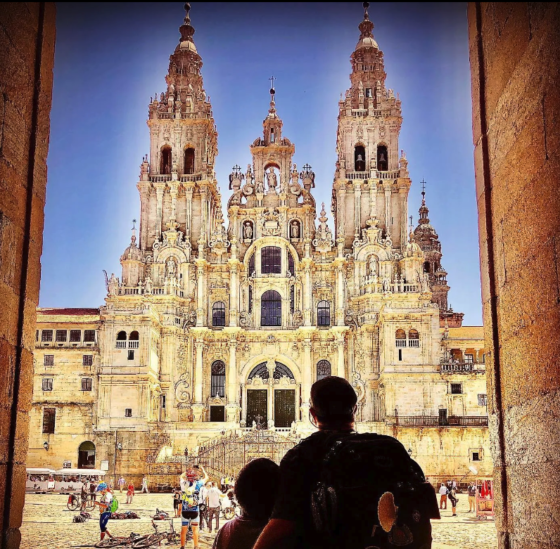
That was my first time doing a pilgrimage walk. Everything was a new experience, and it’s like you go to a museum for the first time, and everything you see is the most fascinating thing. And then you move over four feet and you’re like, ‘Oh, now this is now the most fascinating thing.’
Everything I saw and experienced was so fresh and new. I came up to the UK, and I walked a route that you did as well, from London to Canterbury, and the English Pilgrims’ Way. And I did a bit of a different route than you did, because I wanted to be in Rochester. I walked along the Thames Way and then walked over to Rochester, to be in Rochester Cathedral.
Being in the cathedral in Rochester was very important to me, because the patron saint of adopted children is celebrated there. Having an adopted son, I wanted to pay homage and pay respects in Rochester Cathedral. So that was very special to me.
Arriving in Canterbury was wonderful because, and you saw this too, Jo. You get into this grand cathedral, and you suggested to me not to miss Evensong. That was a really special experience for me, with the choir in the background. I was going on to Dover, to begin the Via Francigena. And that night, another pilgrim was arriving. She had walked the old way from Southampton. Caroline is her name.
The two of us were there and we were receiving a blessing. That night, Caroline’s walk was ending, and mine was going on. I had intended, but for those darn ferries in Dover, I had intended to go on into France and such. And so, my walk was continuing. She gave me a coin, a clay coin, that she had been given, and it had a shell sculpted into the coin and she had carried it with her.
It had been given first by a vicar and then to a pilgrim, and the pilgrim had given it to Caroline. And Caroline had given it to me, and now I was carrying it on. I ended up this year, I was in Italy, and I walked a section of the Via Francigena in Italy and I carried that same pilgrim coin with me to St. Peter’s in Rome. I was able to give it to a pilgrim who was walking on from Rome to Jerusalem. It was so special to see that this sort of connectivity between people and purposes was continuing on with his journey to Jerusalem.
As you said, you and I both had the opportunity to go to Lindisfarne, the Holy Island, and walk across the sands to Holy Island. To me, that was probably one of the most special moments. I will never forget the storm that happened the night before, because, whew, Northumbria, there’s some storms, and that was a big one. Between the wind, the gusts, and the rain, I was really nervous about getting to walk the next morning.
But walking across the receding tides, the north sea, and you see these poles that mark the high route of the sands. And since the time of St. Aidan and St. Cuthbert, people have made their way to Lindisfarne. Following in their footsteps was really incredibly powerful for me. I’ll never forget walking to Holy Island.
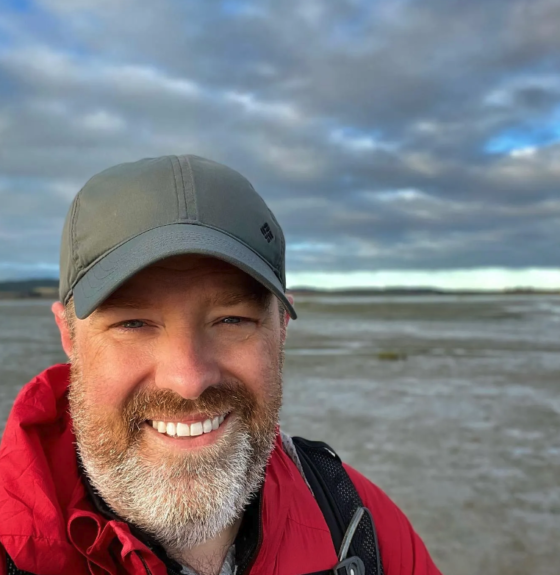
Jo: I’m so glad you mentioned that one. It’s funny, isn’t it, because there are these incredibly grand cathedrals, obviously you mentioned Santiago de Compostela and Canterbury, and I felt it too. And as you were speaking there, I was remembering my own crossing, and yet it is just your feet in the sand and the water.
When I was there, it was a really sunny morning, and the seals were singing, which was just the oddest sound. I couldn’t really see many people, and there’s nobody waiting there, the same as finishing any pilgrimage. There’s no one waiting, going, ‘Wow, you’re amazing. You’ve reached the pinnacle of your journey.’
It’s these, you mentioned earlier, these moments of greater awareness, where we’re so aware of our place on the Earth, physically and spiritually, and part of this great tradition, as you say, and almost just much more in touch with our physical bodies than I feel we are in normal life.
Kevin: Oh, my goodness.
Jo: You know what I mean? Especially with that crossing. Did you do it barefoot?
Kevin: I did it barefoot. It was a visceral experience. You take your shoes off and you pull up your pants legs and you make your way out. Your feet first touch the seawater. And even the receding sea was covering…it hits your toes and it stings them. The water temperature is in the high 50s, and mid-50s. And it’s just, it’s like daggers.
Then it covers your feet. And then all of a sudden, your body adapts to it a little bit, and you’re walking out through the sands, and you kind of feel the sands and you touch these wooden beams, these wooden poles, that are ragged from rising tides and sea air, and the storms that roll in off the coast. You make your way from one to the next to the next.
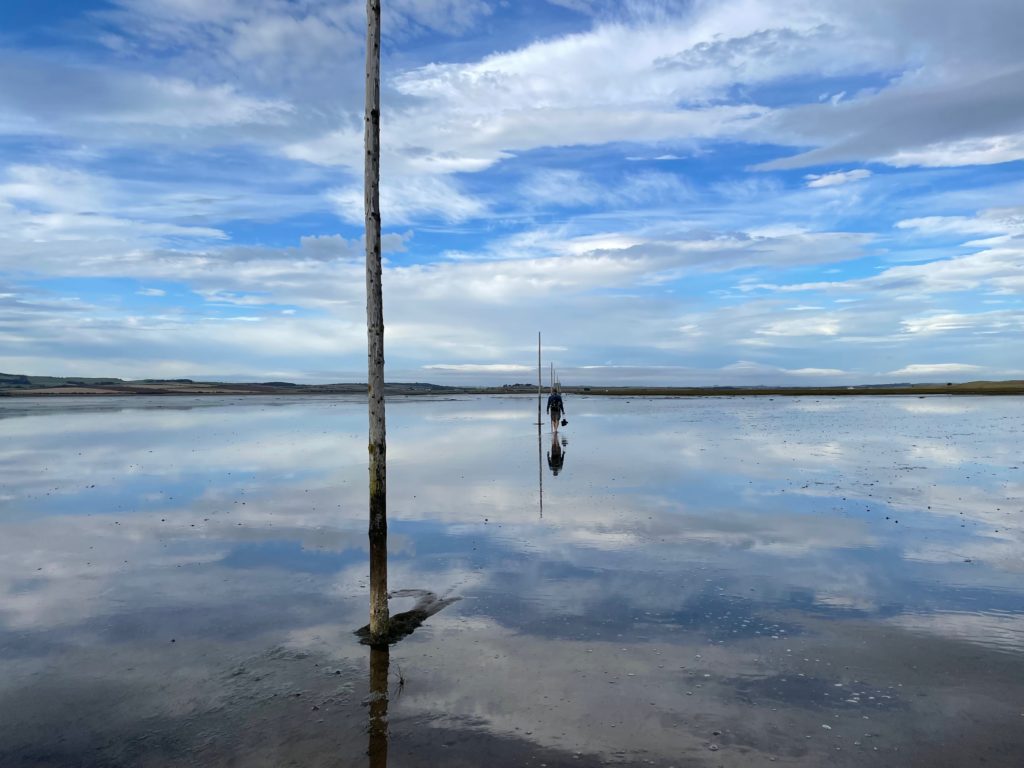
It’s the bottom of the sea floor. So it’s not uniform. You go through these areas where all of a sudden now that stinging water is making its way up my leg and towards my knee. And then you get to a point where it’s a little higher. All of a sudden there’s grasses and such, sea grasses that may be growing there. And there’s a part that even protrudes above the tide most times. And it’s this sucking mud.
Jo: There’s a lot of mud!
Kevin: And you disappear. I disappeared past my knee, whew, right down into the mud. I’m walking and I’ve got my sticks and I’m trying to sort of maneuver my leg out of the mud, back up to make the next step. And it’s, fup, fup, fup, through the mud, and I look over and there’s this wellie that’s sitting there, stuck in the mud, where clearly somebody had just literally walked out of their boot, trying to make their way across. But it’s not a very long section of the walk. It’s maybe, what, Jo? A mile and a half maybe. It’s a short distance.
Jo: Yes. You can do it in an hour, really. An hour and a half, maybe.
Kevin: Yeah. Maybe 90 minutes at the most, and given the conditions. But, like you, I was alone out there. I like how you said the seals were singing and the birds are flying over, and you have to do it at low tide, which means, in many instances, you’re doing it in the very early morning.
For me, this was October, and it was maybe 7:00 in the morning, and the sun was just rising out over the sea to the east. I’ve been to the Vatican and St. Peters. I’ve been to the crypts and the Scavi. I’ve been to the tomb of St. James the Apostle. And as you said, standing in Canterbury and the beautiful cathedrals at Westminster and throughout England.
I don’t know what tops walking to Holy Island across the sea. That was a really special walk, and I’ll never forget the connectivity, like you said, that I felt in those moments.
Jo: I agree. We should also mention if people are going to do it, that it’s quite a shock to then walk into the little town on the island.
Kevin: Oh, absolutely.
Jo: Because you’ll come off the beach, and there’s cars coming on because the tide is down. And then you walk around the corner, and I was in shock at a coachload of literally American tourists, just arrived.
Kevin: Everyone’s on holiday, right? And here you are with your rucksack.
Jo: Suddenly, it’s mad. It’s bonkers. I stayed overnight. You have to book it, obviously. It’s a very small island. But the mass of tourists, they all leave again when the tide comes in, because it is a tidal island. By staying overnight, the atmosphere got a lot more holy again. But while all the people are there in their coaches, it can be a little bonkers. A really interesting place, right?
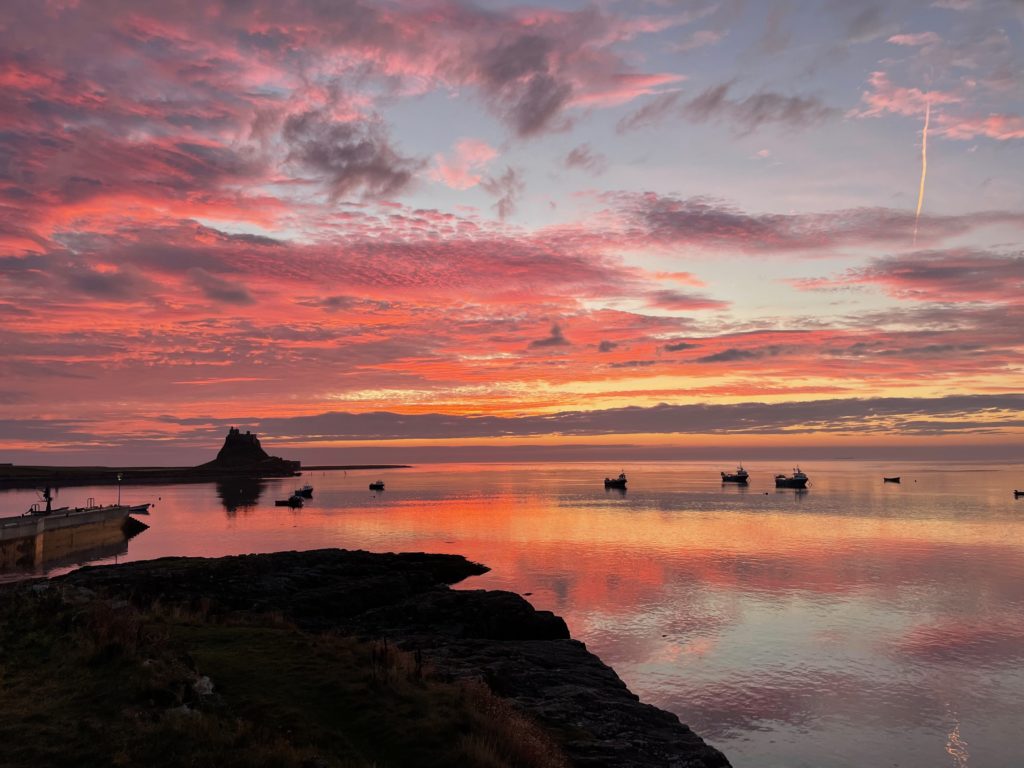
Kevin: Absolutely. From low tide to low tide, it’s a holiday market kind of atmosphere. Everyone’s there, they’re doing their tourist shops, and they’re eating and dropping in the pubs and going to the Lindisfarne Abbey, which is beautifully maintained. And there’s a bit of a fake castle there on the island, which is a bit of a tourist attraction.
There’s sort of an artist element, where people are coming to paint or take photographs, and just walk and explore. But then, once you get to that midway point of the tide, maybe 3:00 in the afternoon or 4:00 in the afternoon, the whole island vacates, and it’s just the local residents and those people who are staying overnight.
I agree with you 100%. I stayed overnight, in a wonderful inn, and the storytelling with the locals, and the opportunity to be with people. A few are on holiday, but a few who were also there to see the Abbey, and were treating it as more of a spiritual destination. You have the island to yourself.
I know there’s always this conflict with over-tourism, but to have it to yourself was really special. Definitely stay the night if you can at Lindisfarne. It was wonderful. It’s easy to catch the train up to Berwick, and then you can get a cab over if you’re just going for a bit, if you aren’t walking the way of St. Cuthbert. I definitely recommend a spot if you haven’t been before.
Jo: For sure. I think pilgrimage has to have its challenges, right? It’s not easy, and the challenges can be physical. They can be spiritual, personal.
What were some of your greatest challenges that you’ve experienced during your pilgrimages?
Kevin: Oh, my goodness. On my very first one, I had spent two years reading, and really trying to understand what the pilgrimage experience was like. Because, to your point, I was a backpacker, and I had done walks, and so I understood how to be a backpacker.
I invested a lot of my preparation into understanding the culture and the camaraderie of pilgrims on the Camino. What I didn’t know to prepare for, or maybe I overlooked, or maybe no one warned me at all, was walking the Portuguese, a lot of the roads, a lot of the paths that you walk on are cobblestones.
As I was walking through these portions of Portugal, you’d go on a cobblestone road for a long stretch, a couple of miles, and then you would go off onto a hard rock stretch and then back onto the cobblestones. It really did a number on my feet. I ended up with what’s called stone bruises on the bottom sole of your feet. Normally, if you have stone bruises, you would want to rest.
Jo: Yeah, stop!
Kevin: Because it’s a bruise on the underside, the sole of your foot. If you’re trying to walk, maybe you can wobble back on your heels, but you certainly can’t go very far very fast. So, I had these stone bruises, and I battled with the stone bruises and just trying to find enough padding, batting that I could put under my foot, between my foot and my shoe, that I could continue my Camino. Because after so many years of preparing, I didn’t want it to be cut short.
I really didn’t want to sacrifice anything that I was looking forward to. So, I had a three or four-day pretty intense battle with the bottom of my feet.
What I learned was that you have to understand exactly where you’re going to be walking, and I didn’t have the right shoes for it. I had my regular walking shoes that I would walk through dirt paths or sand paths and very light underfoot, and a very lightweight type of shoe. I didn’t have a very rugged undersole.
That was a great learning for me. And now ever since, I don’t want to promote any brands, but I’ll tell you that I wear a shoe with a little more rugged undersole, which has been great for me.
Jo: Can you tell us the brand? Because I’m walking that route.
Kevin: Yes. I now wear, pretty much everywhere I go, a max cushioning shoe from Altra, called the ‘Altra Olympus.’ They make that in a men’s and women’s model. And there are a lot of max cushioning shoes, and they’re not for everyone because it’s like having two insoles in your shoe. If you’re a runner or a distance walker, you might feel like you’ve got a little less connectivity to the terrain.
[Imogen Clark mentioned the same issue on the Camino Portuguese, and she recommended HOKA SpeedGoat which also have the thicker sole.]
But if you’re walking with a backpack, on what I came to term as ‘hobblestones,’ that was exactly what you needed and what you wanted. As far as the physicality, this past year, when I was walking through Italy, it’s so darn hot in Europe right now. I was just there, and I walked in May and in June, and the closer you get, it was just so hot, and many places in walking the Via Francigena, especially as you get closer to Rome, the path is an old one.
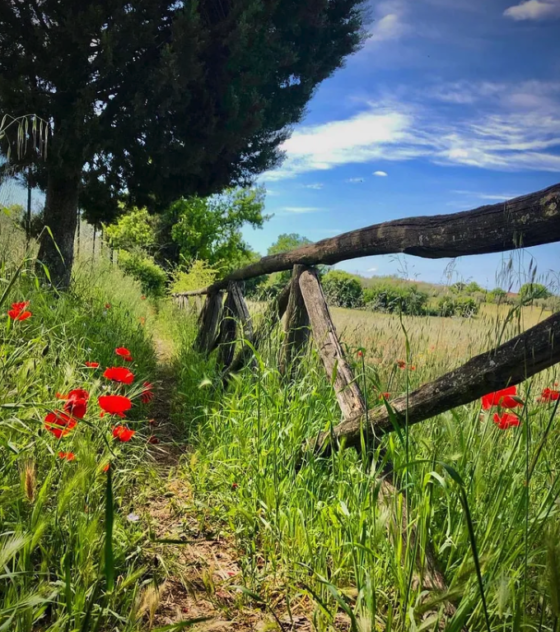
You follow the route of Archbishop Sigeric, who was receiving his papers, if you will, from the Pope in Rome, and then recorded his route back to Canterbury. So, that is the official route from Canterbury to Rome. But as you walk, the towns have moved. Over time, where there used to be maybe less distance from place to place, because of the wars and Punic Wars and things that have all taken place over this time, you end up with cities that used to be there that aren’t there. And so, you’ve got some longer distances just out in the heat. That was very tough.
But the one thing I had no idea of, and you probably know this, Jo, it seems like, because of these battles and the different Papal States that have taken place throughout Italy, almost every little town and city in Italy is on top of a hill. As a walker, you walk 12, 15, 18, 20 miles throughout the day in this heat.
Then at the end of the day, your reward is that you get to go up this just crazy hill to reach the top of the city where you’re going to be sleeping that night, or where you have the opportunity to get dinner.
That was very, very challenging mentally for me because you’re so tired, and it was hot, and you were exhausted from the day. And then you’ve got this big hill push at the end, which sometimes was 400, 600 big, big meters up at the end, over short runs, that really were super challenging. And if there’s one thing I could change, I would flatten that part of Italy.
Jo: It’s interesting because these physical challenges, it is hard. We do put ourselves through this. And, I mean, either it’s really hot, or I remember my last day walking into Canterbury, it rained so hard for so long. I’d put in a really big day, and everything was so, so wet. And it feels like the gifts of pilgrimage don’t show up at the time.
Kevin: No. There are no trumpets that are sounding as you’re walking.
Jo: As you’re doing it. But I find that the gifts of pilgrimage come later. When you have time to reflect on the journey and you’re not just thinking about how much pain you’re in or how hungry you are, or how hot you are.
What are some of the gifts of pilgrimage that have emerged for you later in the process?
Kevin: I do think, in some ways, the physicality of it is an important part of the process. Because pilgrimage in and of itself is such a simple life. You eat, you walk, you pray, if you’re so inclined, and then you sleep.
Walk, sleep. A very simple life.
And you just have with you what’s on your backpack, what you’re carrying. So, you have very few possessions.
But as you go, the physicality, what I found, and you and I talked about this on our podcast together, it quiets the mind, but you become in this state where your body becomes a little numb physically, and you’re no longer aware of you stepped on a rock or whatnot, or you did this or that. It’s just sort of you get into this process of walking.
It opens the mind, I think, a bit to everything else around, and what you can see in these natural places. And the engagement that you have with the things around you.
To answer your question, the things that show up beyond the journey often do come later. For me, I think, well, I’ve had the opportunity to have a deeper connection to understand a bit better what’s important to me, and what I consider to be important faith practices that don’t necessarily involve a physical church.
I’ve become, I think, a little more compassionate for other people. My own awareness of my own sufferings and my own shortcomings, especially when you’re walking, and you’re just physically, you say to yourself, ‘I don’t know if I can take one more step,’ it gives me great empathy for people who are going through something in their lives, physically, emotionally, spiritually. I can definitely put myself in their shoes, and have a greater understanding of their challenges than I ever could before.
I think it’s made me a better father in some ways, because I’m more accepting of my own shortcomings. We tend to build ourselves up a bit. At least I do. I had a very large ego, and I think pilgrimage has been a very humbling experience for me to recognize that you think to yourself, ‘Oh, well, tomorrow’s an easy day.’ And turns out that easy day that you thought was going to be so easy, it rained.
Jo: I don’t think it’s ever an easy day, is there?
Kevin: No, there’s really not, but every day is unique and every day is special. I don’t know that I’ve always had an appreciation for that.
Lastly, I think I’m more aware of the intent that people have had in their own creations. You would go to a museum and you see something that has been painted, and obviously, it’s a masterpiece, and we all recognize the talent and the dedication it would take to do that. But just walking through a small town, a small village, and seeing the very ordinary church that had been constructed, and the less ornate paintings on its walls, that, when that was finished, the whole town must have gathered.
The whole church must have gathered and celebrated this more plain, less ornate, less celebrated fresco if you will, and what it meant to them. I think it’s given me a greater sense of understanding of the intent that people have behind what they do, not judging so much the, what I’m looking at, but what must have gone into it and what it must have meant to the people who were there in those moments.
Jo: That’s fantastic. Of course, this is the ‘Books and Travel Podcast.’
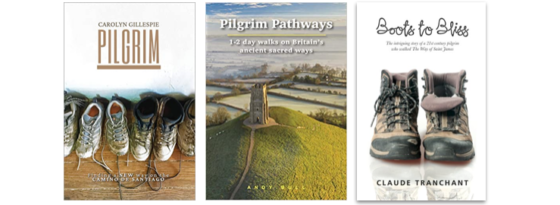
What are some of your favorite books about pilgrimage or particular walking things?
Kevin: I have a few that I’ve finished recently, finished in the last year, that I think are just great. Carolyn Gillespie. Just finished a book called Pilgrim that is a great story of the Camino Frances. Carolyn was a headmaster in a boarding school in England. Scottish lady. And as her children grew and went to university, she ended her professional career.
As an empty nester, now is finding herself without children, where children have been such a huge part of her life, both with the school and her own children. And walk the Camino Frances to give herself the headspace to kind of understand who she might be now. It’s a great book. It’s called Pilgrim by Cary Gillespie.
And another one that I just love, it’s so empowering, is a book by an Australian author Claude Tranchant and Claude…her name is a giveaway, is a French lady, and she walked, at age 64, by herself, alone, from Vezelay to Santiago de Compostela. Claude was not a walker, and had no sense of navigation, and she got lost. Literally, she got lost, and spent some nights in the middle of France, just in nowhere on the side of the road, sleeping on the road.
This little older lady made this journey, and it’s so empowering to me, because there’s a lot of backstory of the things that Claude had put first, ahead of her own self in her life. The Camino showed her what she was truly capable of and what strength she had within. I just love Claude Tranchant’s book. Boots to Bliss is the name of it.
And then for people who are thinking about walking, I mentioned it before, but especially in the UK, Andy’s book, Andy Bull’s book, Pilgrim Pathways, is a great pickup, because it’s written in a way that anybody could walk. It’s in England, Scotland and Wales.
There are 20 short walks, anywhere from a single day to two to three days. A lot of these are sections of longer walks. For example, we talked about the St. Cuthbert’s Way. Andy outlines a section of that, Northern Saints Walk, that you can make, and he shows you how to extend it. But it’s got all the routes, it’s got all the photos, and you can download the GPS routes if you want, and just put it into your OS Maps, and then all of a sudden, you’re a walker. You’re on these pilgrimages.
I just love it. I think it makes what is special to me, walking to these sacred places, so accessible for everyone. So, those are three good ones. Now, there are a lot of Camino books. And I hope to write one myself. I’m almost finished. So, hopefully, I’ll have that for you soon too, Jo.
Jo: Fantastic.
You’re writing Sacred Steps: A Pilgrimage Journal. Is that right?
Kevin: Yes. My first book, Sacred Steps: A Pilgrimage Journal really looks at this intersection of history and faith. The book takes these places that you and I know have been the footpaths of pilgrims for hundreds and now thousands of years, and looks at the historical context as I find myself in some of these places.
It’s really a look at the historical and the modern aspect of pilgrimage along five of these routes that I’ve walked. I don’t think I’ve told anybody this, but I got a little Jo Frances Penn envy when you and I were talking, and you told me, ‘Be careful, because one book could lead to two.’
Jo: Indeed.
Kevin: I’ve also started working on a fiction, a book, The Pilgrims’ Table, which is actually based loosely upon the stories that I’ve experienced and the stories that have been shared on the podcast, where people have encountered really unique and touching experiences throughout their journeys. I’m looking forward to getting that book.
It’s a lot of fun to write fiction, because I’ve never done it before. There’s a lot less fact-checking happening in fiction books, which is great. But it captures that essence of travel as well, and being in these spaces that we all love, and finding something new in discovery, and the things that, unless you go, and you’re in these places, you really just don’t have an appreciation for.
The way they smell, the way this flower dances in the morning light, and the way that the road looks when it’s wet from the rain. I think that’s one of the things we love about travel. Especially for me, slow travel, these walks, when you get to experience places and people and cultures in a way that you never would have on the train or on the plane, or even just motoring by on the highway. That’s become something I’m really so grateful for with these long walks, with these pilgrimage journeys.
Jo: Fantastic.
Where can people find you, and your podcast, and your blog online?
Kevin: Thanks, Jo. The ‘Sacred Steps Podcast’ is available on all of your podcast apps. So, join us. Jo Frances Penn’s episode is on there as well, from season two, so you can grab that one. We’re almost finished recording season three, and getting ready to look to recording season four. So, very excited about that.
The companion websites, sacredstepspodcast.com, sacredstepsbook.com, and then, slowly but surely, thepilgrimstable.com.
Jo: Brilliant. Thanks so much for your time, Kevin. That was great.
Kevin: Jo, it’s delightful to talk to you. I can’t wait to hear more about your upcoming journeys and where you’re going, because the way you have made these spaces come alive, both in your books and on these podcast, is really, truly special. So, thanks for doing it, Jo.
The post Sacred Steps. Pilgrimage With Kevin Donahue appeared first on Books And Travel.